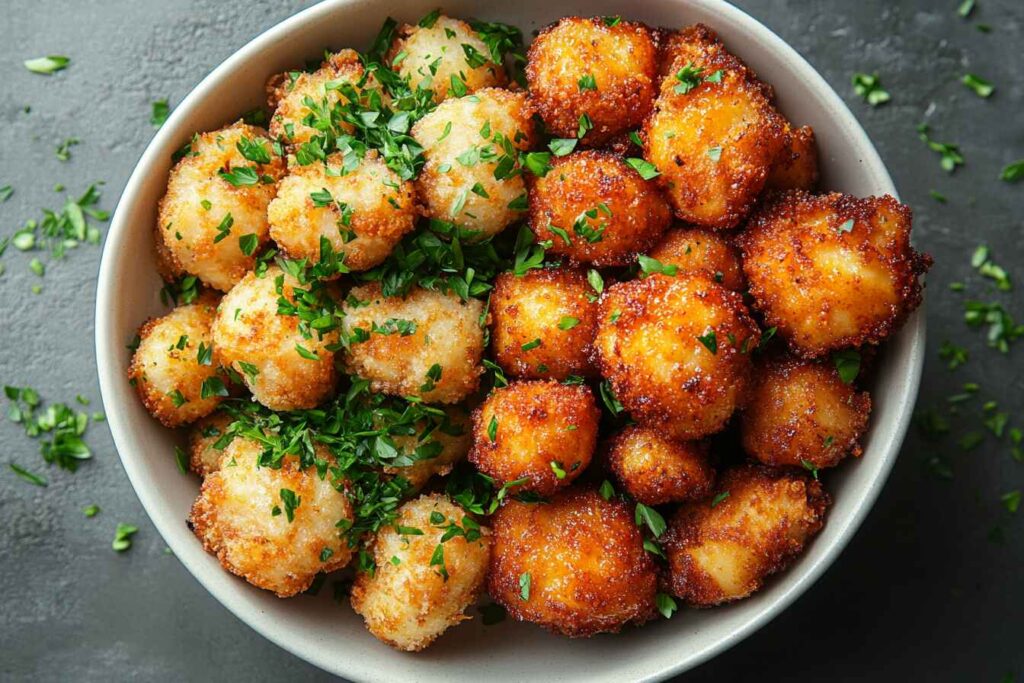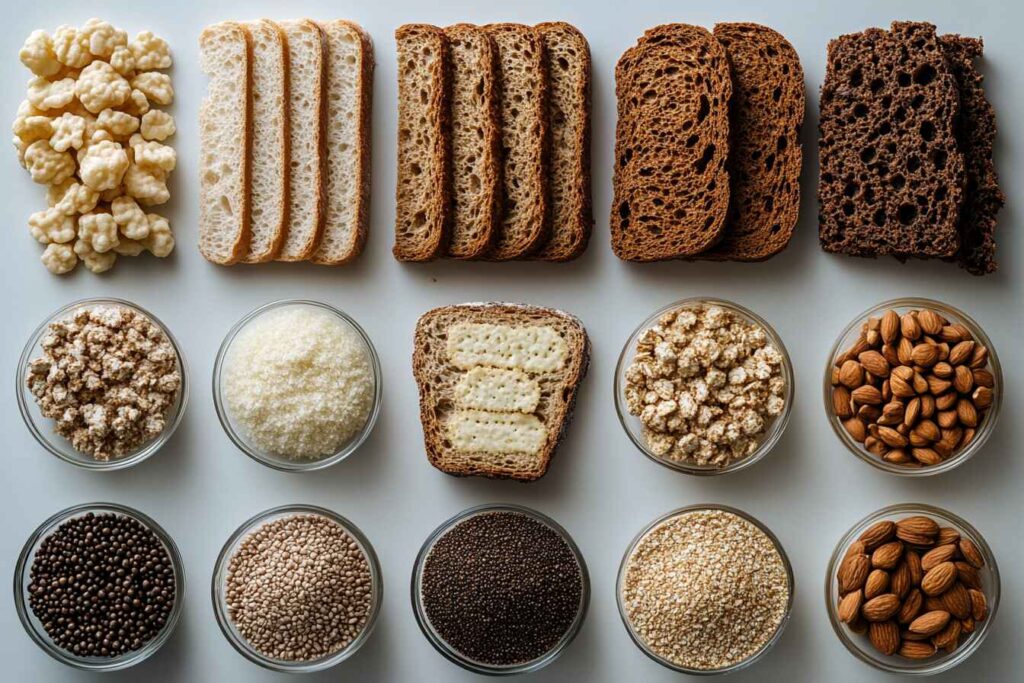Have you ever wondered, “What is a gluten-free substitute for breadcrumbs?” If so, you’re not alone! Many people following a gluten-free diet or dealing with gluten sensitivity often struggle to find a good alternative for traditional breadcrumbs. Thankfully, there are plenty of substitutes that provide the same crunch, binding power, and texture—without the gluten. In this guide, we’ll not only explore the best gluten-free breadcrumb alternatives, but we’ll also show you how to use them effectively. Moreover, we’ll share expert tips to ensure your dishes turn out just as delicious as ever!
Table of Contents
Why Do People Need Gluten-Free Breadcrumbs?
Gluten Sensitivity and Celiac Disease
A gluten-free substitute for breadcrumbs is essential for those with celiac disease, gluten intolerance, or dietary preferences. Since traditional breadcrumbs contain wheat, they are off-limits for those avoiding gluten. Thankfully, there are several options available that work just as well!
Gluten Sensitivity and Celiac Disease
For individuals with **celiac disease or gluten sensitivity**, consuming even a small amount of gluten can lead to bloating, stomach pain, and other health issues. Using a safe gluten-free substitute for breadcrumbs ensures that meals remain both delicious and safe to eat.
Fun Fact: Many gluten-free breadcrumb alternatives are also lower in carbs and higher in protein, making them great for weight loss and fitness-focused diets.
The Role of Breadcrumbs in Cooking and Baking
Before we dive into the best gluten-free substitutes, let’s talk about why breadcrumbs are so important in cooking. They’re more than just a filler—breadcrumbs affect texture, moisture, and even flavor.
Binding Agent in Recipes
Have you ever tried making meatballs or burgers without breadcrumbs? If so, you probably know it can be a complete disaster! Without breadcrumbs, the mixture becomes too wet and falls apart easily. However, when added, breadcrumbs absorb excess moisture, binding everything together and ensuring your meatballs or burgers hold their shape perfectly.
Coating for Frying and Baking
That crispy golden crust on fried chicken or baked fish? Yup, that’s thanks to breadcrumbs. When mixed with seasonings and a bit of oil, they create the perfect crunchy layer that locks in moisture.
Thickening Soups, Sauces, and Casseroles
Breadcrumbs work as a natural thickener in creamy soups, casseroles, and even macaroni and cheese. They soak up excess liquid, making dishes rich and hearty.
Tip: If you’re making a gluten-free dish that needs thickening, consider using almond flour or ground oats as a substitute for breadcrumbs.
Common Problems When Substituting Breadcrumbs
Replacing breadcrumbs isn’t always straightforward. Here are some challenges people face:
- Texture Issues: Some gluten-free substitutes might be too soft or too dense.
- Absorption Problems: Certain alternatives soak up too much moisture, making food dry.
- Lack of Crispiness: Not all substitutes deliver the same crunchy coating.
But don’t worry! In the next sections, we’ll explore the best gluten-free breadcrumb substitutes, their ideal uses, and how to make them work in your favorite recipes.

The Best Gluten-Free Substitutes for Breadcrumbs
Each gluten-free substitute for breadcrumbs has its ideal use case. For example, crushed cornflakes work well for crispy coatings, while almond flour is perfect for binding meatballs and meatloaf. To achieve the best results, choose a substitute based on your recipe’s needs.
1. Almond Flour
Best for: Meatballs, meatloaf, and keto-friendly breading.
Among the many gluten-free alternatives, almond flour stands out as one of the most popular choices. Not only does it have a mild, nutty flavor that enhances savory dishes without overwhelming them, but it also offers a great nutritional profile. Furthermore, since it’s low in carbs and high in protein, it’s an excellent option for those following a keto diet.
Tip: To make almond flour crispier, toast it lightly before using it as a coating.
2. Coconut Flour
Best for: Thickening soups and breading fish or chicken.
Coconut flour absorbs a lot of moisture, making it great for thickening sauces. However, because it’s **highly absorbent**, you’ll need to use less than you would with traditional breadcrumbs.
3. Crushed Cornflakes
Best for: Crispy coatings on fried chicken or fish.
Crushed cornflakes are a fantastic substitute when you want a **crunchy, golden crust**. They add a slight sweetness, which pairs well with savory dishes.
Nutrition Facts (Per 1/2 Cup of Crushed Cornflakes):
Calories 50 Carbs 12g Protein 1g Fat 0g
4. Ground Oats or Oat Flour
Best for: Binding meatballs, meatloaf, and veggie burgers.
Oats provide a **mild, neutral flavor** and work well as a gluten-free binder. Just make sure you’re using **certified gluten-free oats** to avoid cross-contamination.
5. Gluten-Free Panko
Best for: Light and crispy coatings.
If you love the light crunch of panko breadcrumbs, you’re in luck! Many brands now offer **gluten-free panko**, which mimics the texture of traditional panko.
6. Chopped Nuts (Walnuts, Pecans, or Almonds)
Best for: Adding crunch to baked dishes.
Finely chopped nuts add **a crunchy texture and rich flavor**. They’re perfect for breading chicken or adding a crispy topping to casseroles.
7. Quinoa Flakes
Best for: Thickening soups or adding crunch.
Quinoa flakes are **high in protein and fiber**, making them a nutritious alternative to breadcrumbs.
8. Rice Crackers or Rice Flour
Best for: Crisp coatings and frying.
Crushed rice crackers create a crispy coating, while rice flour works as a great thickening agent for soups and sauces.
9. Mashed Potatoes (for Binding)
Best for: Meatloaf and veggie patties.
Mashed potatoes act as a **moist binder** and work well in recipes where you don’t need a crispy texture.
10. Psyllium Husk or Chia Seeds
Best for: Binding gluten-free doughs.
Psyllium husk and chia seeds absorb moisture and create a **gel-like texture**, making them great for binding.
Comparing the Substitutes: Best Uses for Each
Here’s a quick guide to help you choose the best gluten-free substitute based on your needs:
| Substitute | Best Used For | Crunchy? |
|---|---|---|
| Almond Flour | Meatballs, coatings, keto recipes | No |
| Coconut Flour | Thickening soups, breading fish | No |
| Crushed Cornflakes | Fried coatings, baked dishes | Yes |
| Ground Oats | Binding burgers, meatballs | No |
| Gluten-Free Panko | Crispy coatings | Yes |
| Chopped Nuts | Crunchy toppings, coatings | Yes |
| Quinoa Flakes | Soups, crunchy textures | Yes |
| Rice Crackers | Frying, thickening | Yes |
| Mashed Potatoes | Binding meatloaf, patties | No |
| Psyllium Husk | Binding gluten-free dough | No |

How to Choose the Right Substitute for Your Recipe
Not all substitutes work for every dish. Here’s how to pick the best one:
- For frying: Use crushed cornflakes, gluten-free panko, or rice crackers.
- For binding: Almond flour, oat flour, or mashed potatoes.
- For thickening: Coconut flour, psyllium husk, or quinoa flakes.
Tip: If your substitute absorbs too much moisture, add an extra egg or liquid to balance it out.
How to Make Homemade Gluten-Free Breadcrumbs
If you love **DIY cooking**, making your own gluten-free breadcrumbs is an excellent option. Not only is it **cost-effective**, but it also allows you to control the ingredients, ensuring that no hidden gluten sneaks in. Furthermore, homemade breadcrumbs can be customized with herbs and spices to enhance flavor.
Ingredients
Basic Gluten-Free Breadcrumbs Recipe
Ingredient Quantity Gluten-free bread (stale or toasted) 4-5 slices Salt (optional) 1/2 tsp Garlic powder (optional) 1/2 tsp Olive oil (for crispier texture) 1 tbsp
Instructions
- First, preheat your oven to **300°F (150°C)**.
- Next, toast your gluten-free bread slices until they become **golden and dry**.
- After that, let them cool completely to avoid steam making them soft.
- Then, break the bread into smaller pieces and pulse in a food processor until **fine crumbs form**.
- Spread the crumbs on a baking sheet and bake for **5-7 minutes** to add extra crispiness.
- Finally, allow them to cool before storing in an airtight container.
Storage Tip: Homemade gluten-free breadcrumbs stay fresh for **up to 2 weeks** in an airtight container or **3 months** in the freezer. For best results, store in a cool, dry place.
Common Problems and Solutions When Using Gluten-Free Breadcrumbs
Switching to gluten-free breadcrumbs isn’t always seamless. However, being aware of common challenges and their solutions can make the transition smoother.
Problem #1: The Substitute is Too Absorbent
Some gluten-free substitutes, like **coconut flour or oat flour**, absorb excessive moisture, making your dish **too dry**.
Solution:
- Reduce the amount of your breadcrumb substitute by **25-30%** to prevent dryness.
- Additionally, add **an extra egg** or a small amount of liquid to balance moisture levels.
- Instead of coconut flour, try using **crushed cornflakes or gluten-free panko**, which absorb less liquid.
Problem #2: The Coating Doesn’t Get Crispy
One of the biggest disappointments when using gluten-free alternatives is the lack of **crunchiness** in fried or baked dishes. This happens because some substitutes don’t brown as well as traditional breadcrumbs.
Solution:
- To achieve a crispier finish, use **crushed rice crackers, gluten-free panko, or cornflakes**.
- Moreover, lightly coat the food with **olive oil or butter** before baking.
- For best results, try **double-coating**: Dip the food in an egg wash, then in the breadcrumb substitute, and repeat the process.
Problem #3: The Binding Power is Too Weak
Gluten helps hold food together, so without it, meatballs or patties may fall apart. Fortunately, there are ways to ensure your gluten-free recipes stay intact.
Solution:
- Use **chia seeds, psyllium husk, or mashed potatoes** as a natural binder.
- Furthermore, let the mixture **rest for 10-15 minutes** before cooking to allow it to set properly.
- If necessary, increase the number of **eggs or another binding ingredient**.
Tips for Cooking with Gluten-Free Breadcrumbs
To get the best results from your gluten-free breadcrumb alternatives, follow these **simple but effective tips**.
1. Choose the Right Substitute for the Recipe
Not all gluten-free substitutes work for every dish. Therefore, it’s important to select the most suitable one:
- For crispy coatings: **Crushed cornflakes, rice crackers, gluten-free panko**.
- For binding meatballs or burgers: **Almond flour, oat flour, mashed potatoes**.
- For thickening soups: **Coconut flour, quinoa flakes, psyllium husk**.
2. Experiment with Seasonings
Since gluten-free breadcrumbs have different flavors, adding **herbs and spices** can enhance taste and texture.
Best Seasonings for Gluten-Free Breadcrumbs:
Seasoning Best For Garlic powder Coatings, meatballs Paprika Fried chicken, seafood Parmesan cheese Casseroles, coatings Italian seasoning Meatballs, burgers
3. Store Properly to Maintain Freshness
Unlike traditional breadcrumbs, many gluten-free options **don’t contain preservatives**. As a result, proper storage is essential to prevent spoilage.
- **Keep in an airtight container** to maintain freshness and prevent moisture absorption.
- For long-term storage, place breadcrumbs in the **freezer** to extend shelf life.
- To achieve extra crispiness, use a **dehydrator** before storing.
Conclusion: Finding the Best Gluten-Free Breadcrumb Alternative for You
Finding the perfect gluten-free substitute for breadcrumbs doesn’t have to be a challenge. With so many options available, you can easily replace traditional breadcrumbs in your favorite recipes. Whether you choose almond flour, crushed cornflakes, or gluten-free panko, there is a gluten-free substitute for breadcrumbs that will suit your needs.
Moreover, knowing how to use each alternative properly will help you achieve the best texture and flavor. For example, if you need a crispy coating, crushed cornflakes or rice crackers work wonders. On the other hand, almond flour or oat flour makes a great binder for meatballs and burgers. No matter what dish you’re preparing, there’s always a gluten-free substitute for breadcrumbs that will work perfectly.
Ultimately, switching to a gluten-free substitute for breadcrumbs doesn’t mean sacrificing taste or texture. By experimenting with different options and following the right cooking techniques, you can create delicious meals that everyone will enjoy. So, the next time you need breadcrumbs, try one of these gluten-free alternatives and elevate your cooking

